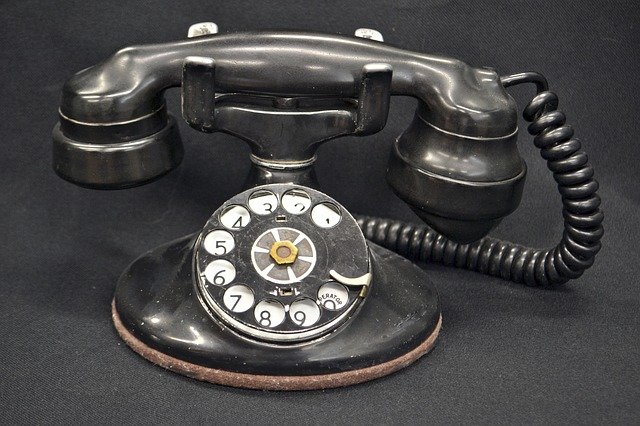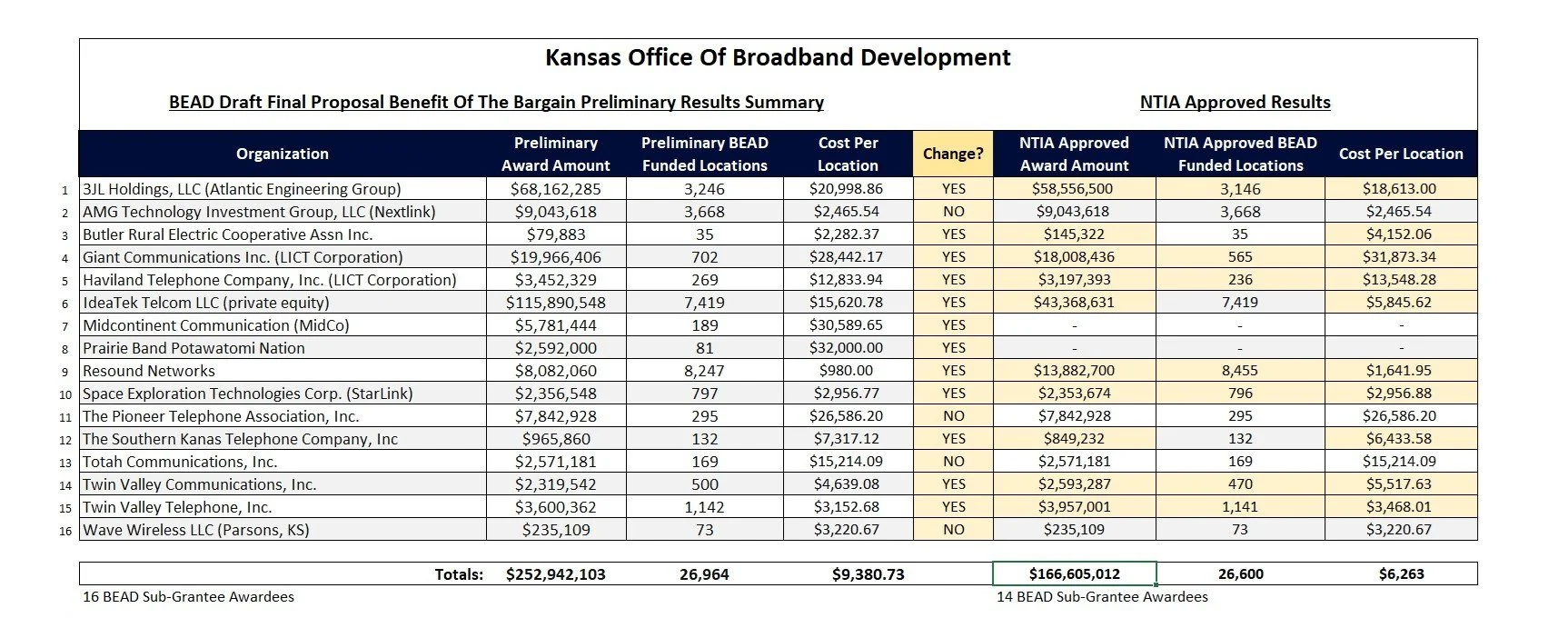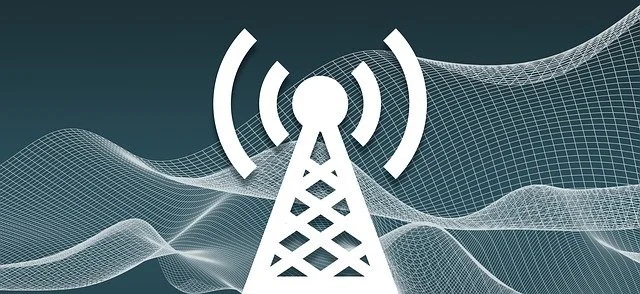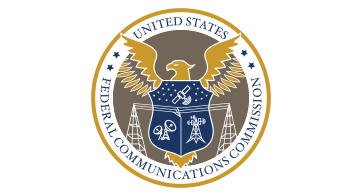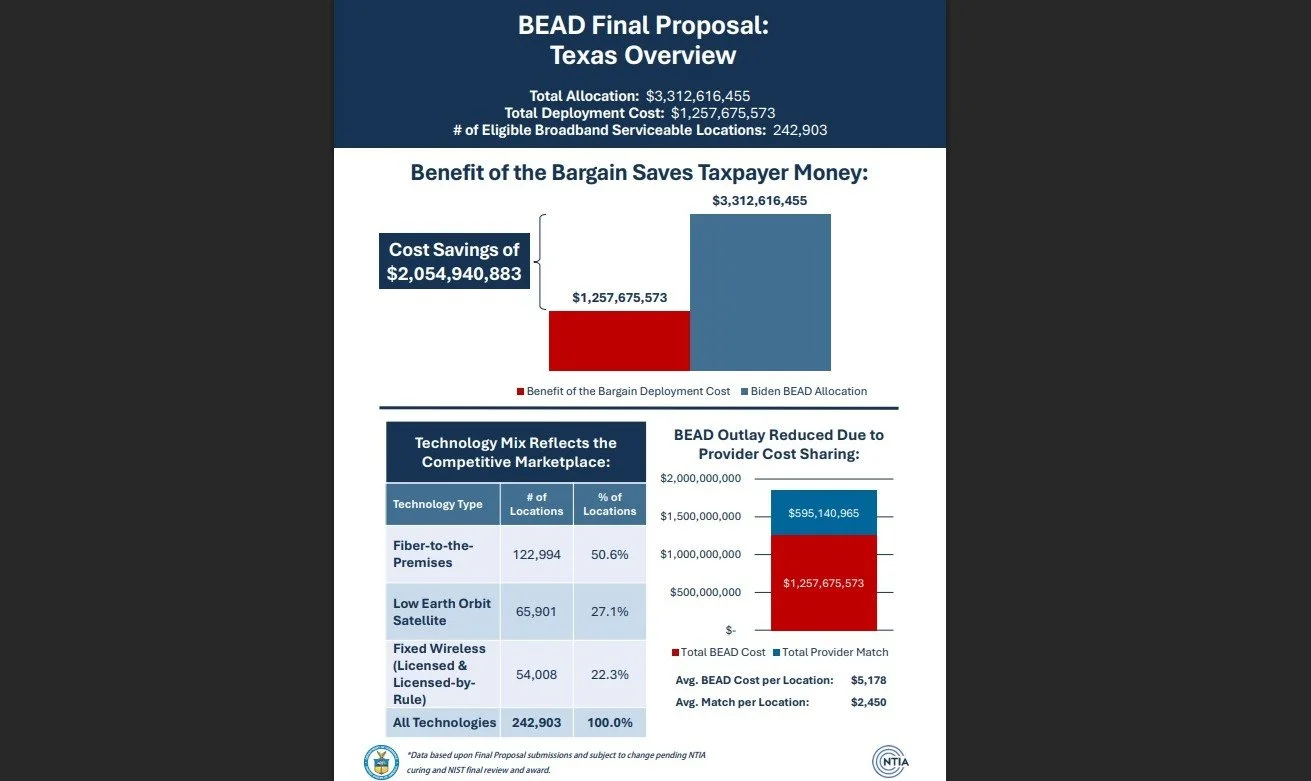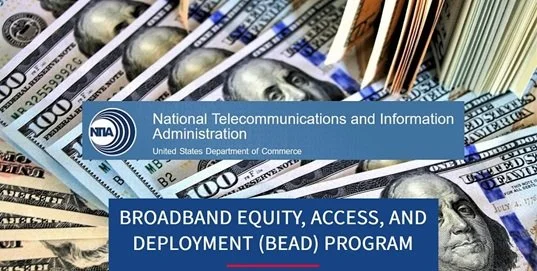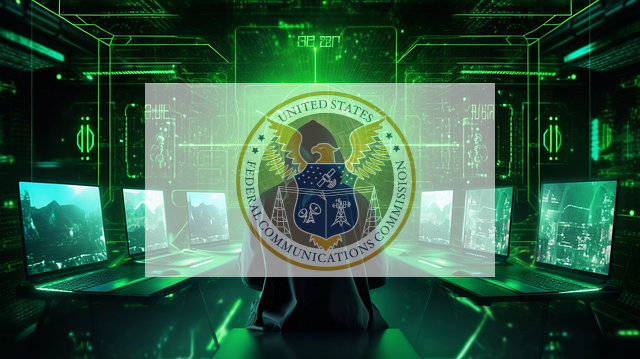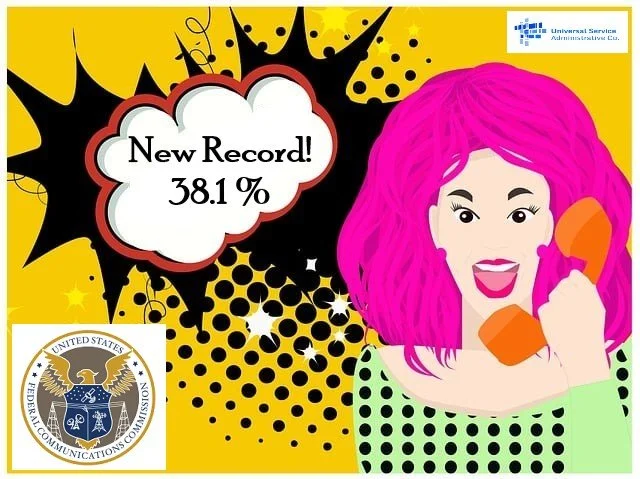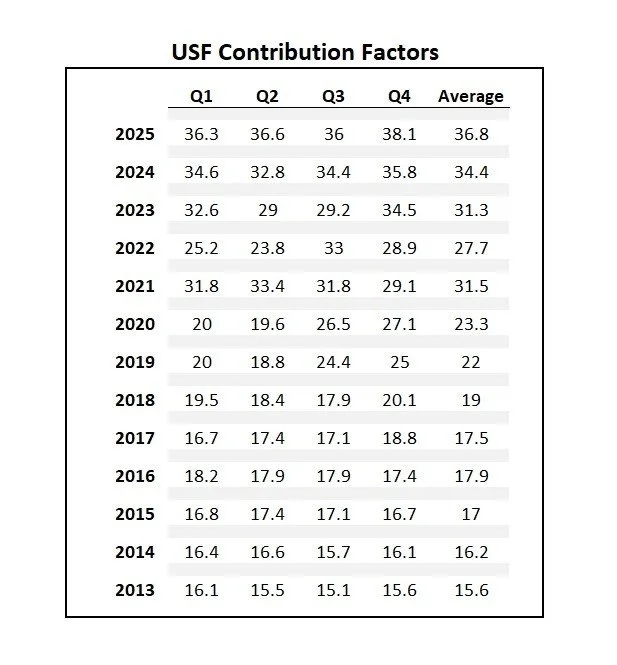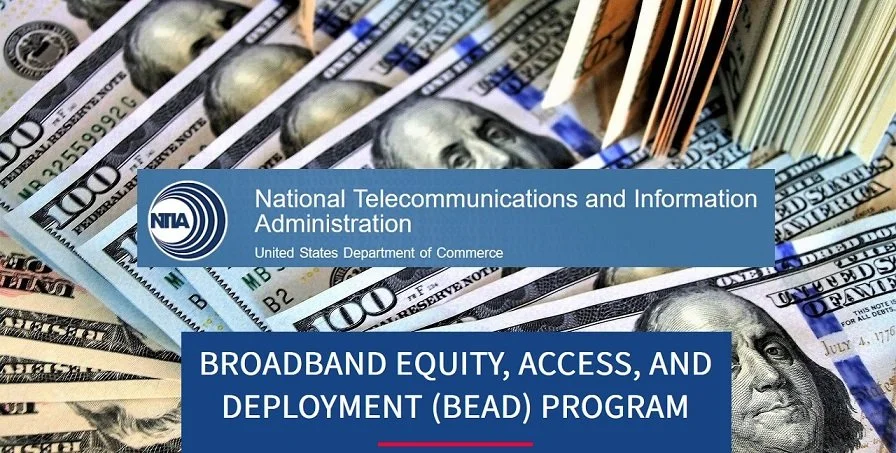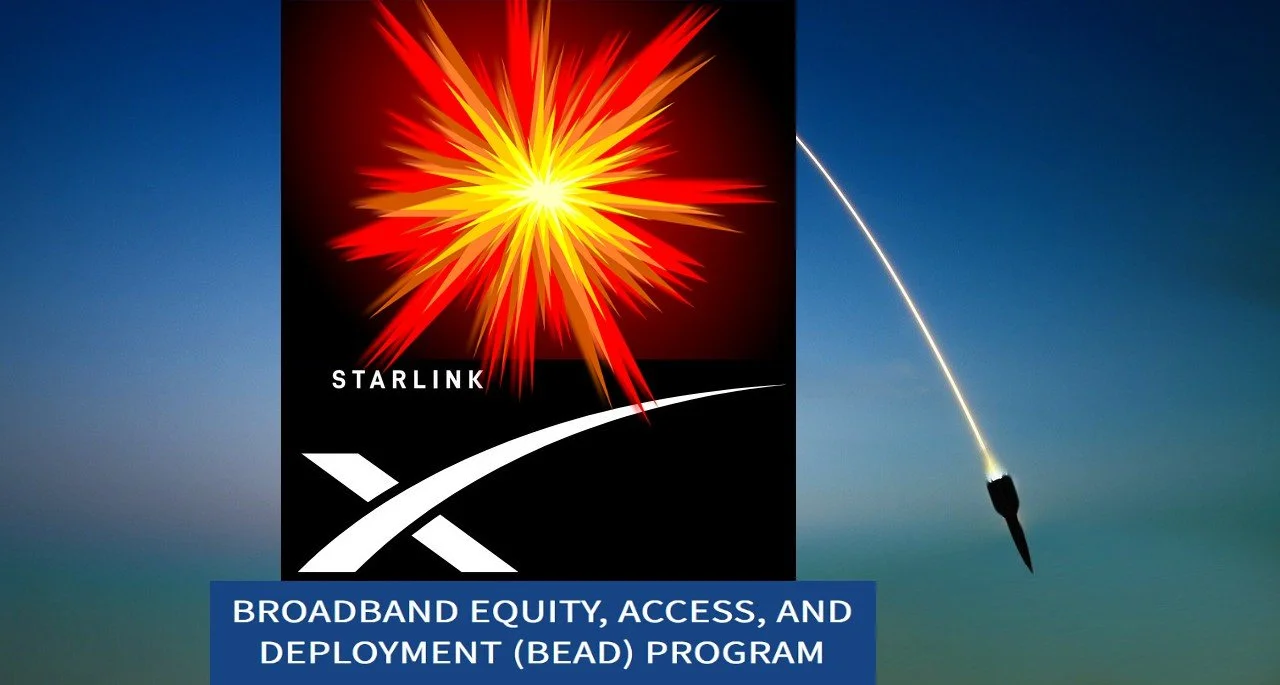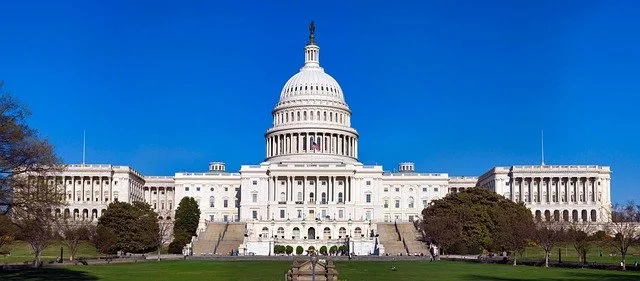The Latest News
FCC | Broadband | Wireless | Congress
Congressional Universal Service Fund Working Group Asks FCC To Provide Staff-Level Briefing On USF Issues
December 17, 2025 – Members of the Senate’s Universal Service Fund Working Group have asked the Federal Communications Commission (FCC) to give them a briefing on universal service issues. Senators Deb Fischer (R-NE) and Ben Ray Luján (D-NM), and U.S. Representatives Richard Hudson (R-NC9) and Doris Matsui (D-CA7), made the request in a letter to the FCC. They want an FCC staff-level briefing that will “provide insight on the implementation of Congress’ universal service directives and help inform the Working Group’s leadership to modernize the Fund.” The Universal Service Fund Working Group have requested that the FCC have the appropriate personnel coordinate a convenient time for the briefing no later than January 30, 2026, and cover the following topics:
The most recent program outlays and cost projections across each USF program;
Assessment of the USF contribution factor and recent fluctuations;
Rulemakings or reforms of USF programs under consideration by the Commission; and
Any administrative challenges, program integrity concerns, or operational updates pertinent to congressional oversight of the Fund.
USF Contribution Factor Dips To 37.6% For First Quarter Of 2026
December 15, 2025 – The FCC’s Office of Managing Director (OMD) has announced that the proposed universal service fund (USF) contribution factor for the first quarter of 2026 will be 37.6 percent. If the FCC takes no action on the proposed USF contribution factor within 14 days, it will be declared approved.
The 37.6% contribution factor for 1Q 2026 is a slight decrease from 38.1% which was used for 4Q 2025 and which was an all-time high. Historical information on quarterly universal service fund contribution factors is available online from the FCC.
For the first quarter of 2026, the Universal Service Administrative Company (USAC) projects $7.604471 billion in total interstate and international end-user telecommunications revenues will be collected. USAC estimates that $2.060770 billion is needed to cover the total demand and expenses for all Federal universal service support mechanisms (revenue requirement) in the first quarter of 2026. Total first quarter 2026 demand includes projected program support, administrative expenses, and true-ups and adjustments, which breaks out among the USF support mechanisms as follows:
E-Rate Schools & Libraries: $648.93 million
Rural Health Care: $181.11 million
High-Cost: $1.00545 billion
Lifeline: $225.28 million
Executive Order Attempts To Prevent State Regulation Of Artificial Intelligence; States Must Eliminate “Onerous” AI Laws To Receive Any Remaining BEAD Funding
December 11, 2025 – President Trump has issued an Executive Order which is aimed preventing states from regulating artificial intelligence (AI). The EO announces that “it is the policy of the United States to sustain and enhance the United States’ global AI dominance through a minimally burdensome national policy framework for AI.” To implement this policy, the EO announces that “within 30 days of the date of this order, the Attorney General shall establish an AI Litigation Task Force (Task Force) whose sole responsibility shall be to challenge State AI laws inconsistent with the policy set forth in section 2 of this order, including on grounds that such laws unconstitutionally regulate interstate commerce, are preempted by existing Federal regulations, or are otherwise unlawful in the Attorney General’s judgment, including, if appropriate, those laws identified pursuant to section 4 of this order.” Among other things, the EO restricts states’ eligibility to receive any remaining BEAD program non-deployment funding on the condition that they pledge to eliminate “onerous” AI laws:
Sec. 5. Restrictions on State Funding. (a) Within 90 days of the date of this order, the Secretary of Commerce, through the Assistant Secretary of Commerce for Communications and Information, shall issue a Policy Notice specifying the conditions under which States may be eligible for remaining funding under the Broadband Equity Access and Deployment (BEAD) Program that was saved through my Administration’s “Benefit of the Bargain” reforms, consistent with 47 U.S.C. 1702(e)-(f). That Policy Notice must provide that States with onerous AI laws identified pursuant to section 4 of this order are ineligible for non-deployment funds, to the maximum extent allowed by Federal law. The Policy Notice must also describe how a fragmented State regulatory landscape for AI threatens to undermine BEAD-funded deployments, the growth of AI applications reliant on high-speed networks, and BEAD’s mission of delivering universal, high-speed connectivity.
Mergers & Acquisitions: Oak Hill Capital Acquiring Hunter Communications (Oregon)
December 10, 2025 – Private equity firm Oak Hill Capital has announced that it has entered into an agreement to acquire Hunter Communications, the largest privately owned fiber-optic internet provider in the state of Oregon. Hunter Communications was founded in 1994 and is headquartered in Medford, Oregon. According to the press release, the company’s fiber network spans more than 3,000 route miles and passes approximately 100,000 locations. It provides multi-gig symmetrical speeds, low latency, and high network availability to more than 25,000 customers across the Pacific Northwest. Oak Hill’s acquisition is expected to help Hunter Communications’ fiber-to-the-premises (FTTP) network expansion plan around its existing fiber footprint in Oregon and Northern California. The transaction is subject to customary closing conditions and regulatory approvals. Financial terms have not been publicly disclosed.
NTIA Approves Kansas’ BEAD Program Final Proposal & Awards
December 8, 2025 – Kansas Governor Laura Kelly has announced that the National Telecommunications and Information Administration (NTIA) has approved the Kansas Office of Broadband Development’s (KOBD) $166.6 million final proposal for the Broadband Equity, Access and Deployment (BEAD) program.
The final proposal approved by NTIA selects 14 awardees to receive a total of $166,605,012 in BEAD grant funding. (KOBD originally selected a total of 16 awardees to receive a total of $252,942,107 in BEAD grant funding.)
The $166,605,012 in total awarded BEAD funding represents a loss of 63% in federal funding for the state of Kansas due to the Benefit of the Bargain Round (Kansas was allocated $451 million).
Total BEAD funding broken down by type of technology is as follows: fiber – 30%; fixed wireless – 67%; and Low Earth Orbit (LEO) satellite service – 3%.
The awards are considered final by NTIA and will now move into the NIST approval process. Thereafter, KOBD will begin the next phase of its BEAD implementation, which includes finalization of BEAD subgrantee contracts, oversight of subgrantee compliance, and continued technical assistance. KOBD expects BEAD subgrantees will commence the groundbreaking of their funded projects during the second half of 2026. Additional specific changes from the original draft final proposal to what was approved by NTIA are shown below.
FCC Resolves Outstanding Enhanced A-CAM Support Recalculations Issues & Releases Updated Interim List Of Eligible Locations
December 8, 2025 – The FCC’s Wireline Competition Bureau (Bureau) has released an Order that resolves several outstanding issues relating to the Enhanced Alternative Connect America Cost Model (E-ACAM or Enhanced A-CAM) support program. Primarily, the Order explains how support recalculations will work for carriers whose total number of obligated locations has changed between the initial E-ACAM authorization and the current updated location list. Also, in the Order, the Bureau responds to several comments from interested parties proposing modifications to E-ACAM funding, and sets forth the timeline when the E-ACAM support recalculations will occur. In a concurrent Public Notice, the Bureau has released an updated interim list of locations that are eligible for E-ACAM support, along with a tentative list of support amounts for E-ACAM carriers which reflects the updated interim list of locations.
Robocall Further Notice Of Proposed Rulemaking Comments Due January 5, 2026
December 5, 2025 – The Federal Communications Commission’s (FCC) robocall Further Notice Of Proposed Rulemaking (FNPRM) has been published in the Federal Register. As a result, comments are due on or before January 5, 2026. Reply comments are due on or before February 3, 2026. In the FNPRM, the FCC proposes, among other things, the following changes to its robocall rules:
The FCC proposes to enhance the effectiveness of STIR/SHAKEN by requiring terminating voice service providers to transmit verified caller name for presentation on consumers’ handsets whenever they transmit call authentication information indicating that the originating number is unlikely to be spoofed (i.e., a call has received an A-level attestation).
The FCC further proposes ways for originating voice service providers to verify that the caller name and other information about the caller that they transmit is accurate and secure so that consumers can trust it.
The FCC seeks comment on requiring providers to use Rich Call Data (RCD) to transmit verified caller name on IP networks, whether to permit or require use of other solutions, and an alternative option to require that providers implement RCD in their IP networks for all calls.
Because many unlawful robocalls originate from outside the United States, the FCC proposes to ensure that consumers know which calls originate from a foreign country and to improve call blocking analytics by considering whether a call originated from outside of the United States.
The FCC also seeks comment on whether some of its calling-related rules can be simplified, streamlined, or eliminated, perhaps because they are outdated or have not been enforced for a substantial amount of time.
C-Band Auction Notice Of Proposed Rulemaking Comments Due January 5, 2026
December 5, 2025 – The Federal Communications Commission’s (FCC) C-Band spectrum auction Notice Of Proposed Rulemaking (NPRM) has been published in the Federal Register. As a result, comments are due on or before January 5, 2026. Reply comments are due on or before February 3, 2026. In the NPRM, the FCC proposes “to further expand the ecosystem for next generation wireless services in the 3.7–4.2 GHz band (C-band) by making as much as 180, and at least 100, megahertz of the 3.98–4.2 GHz band (Upper C-band) available for terrestrial wireless flexible use via a system of competitive bidding.” Comment is sought on, among other things, the following details and proposals:
The FCC proposes to make additional spectrum in the Upper C-band available for new terrestrial wireless operations within the congressionally mandated timeframe.
As with the earlier 3.7–3.98 GHz (Lower C-band) transition, the FCC seeks to expeditiously transition incumbent operations in the Upper C-band in keeping with its Emerging Technologies precedent.
The FCC seeks to reinforce a successful coexistence environment by facilitating the timely introduction of new, high-powered terrestrial wireless operations in the Upper C-band alongside a generational upgrade to radio altimeters that facilitates aviation safety through operations in the adjacent 4.2–4.4 GHz band that can safely coexist with wireless services.
The FCC seeks comment on proposals to enable terrestrial wireless operations in a segment of the Upper C-band in the contiguous United States, to reserve no more than 20 megahertz as a guard band between those wireless operations and Fixed Satellite Services (FSS), and to generally apply the part 27 licensing and operating rules that presently govern wireless operations in the Lower C-band to new full-power commercial operations in the Upper C-band.
The FCC requests that commenters provide specifics on the costs and benefits of the FCC’s proposals, and of potential alternatives, in addition to detailed technical analyses and other studies in support of commenters’ positions.
Comments Dates Announced For Second FNPRM Proposing To Eliminate Six FCC Broadband Label Requirements (January 2, 2026 & February 2, 2026)
December 3, 2025 – The Federal Communications Commission’s (FCC) Second Further Notice Of Proposed Rulemaking (FNPRM) on broadband labels has been published in the Federal Register. As a result, comments in response to the FNPRM are due on or before January 2, 2026. Reply comments are due on or before February 2, 2026.
In the FNPRM, the FCC proposes to eliminate requirements that providers: (1) read the label to consumers over the phone; (2) itemize state and local passthrough fees that vary by location; (3) provide information about the now-concluded Affordable Connectivity Program (ACP); (4) display labels in customer account portals; (5) make labels available in machine readable format; and (6) archive labels for at least two years after a service is no longer offered to new customers. The FCC also is seeking comment on streamlining and eliminating any other consumer broadband label requirement, such as the multilingual display requirement, that may be unduly burdensome and costly. The FCC also proposes to end our inquiry into new requirements that would take the labels out of alignment with the authorizing statute.
In a November 2022 Report And Order, the FCC adopted rules requiring internet service providers (ISPs) to display, at the point of sale, labels that disclose certain information about broadband service prices, introductory rates, data allowances, and broadband speeds, and to include links to information about their network management practices, privacy policies, and the FCC’s Affordable Connectivity Program (ACP). Broadband consumer labels resemble nutrition labels that appear on food products. The FCC adopted one label requiring the same information and in the same format for both fixed and mobile broadband service offerings. In October 2023, the FCC announced the compliance dates for the its broadband consumer label rules. Broadband providers with 100,000 or fewer subscribers were required to comply with the requirements to display broadband labels as of October 10, 2024. All other broadband providers were required to display broadband labels as of April 10, 2024. Compliance with the requirement in Section 8.1(a)(2) to make labels accessible in online account portals were required for all broadband providers as of October 10, 2024. Compliance with the requirement in Section 8.1(a)(3) to make information in broadband labels available in a machine-readable format was required for all providers as of October 10, 2024.
FCC Terminates 2,048 Dormant Proceedings; Keeps Nine Alive
December 3, 2025 – The FCC’s Consumer & Governmental Affairs Bureau (Bureau) has issued an Order that terminates, as dormant, 2,048 FCC proceedings. According to the Bureau, terminating the dormant proceedings “furthers the Commission’s goals of increasing decision-making efficiency, modernizing agency processes in the digital age, and enhancing openness and transparency for both practitioners and the public.” Nine proceedings that were listed to be terminated were kept alive. When the Order is published in the Federal Register, the dormant proceedings will be terminated in the FCC’s Electronic Comment Filing System (ECFS).
In May 2025 the Bureau released a Public Notice that sought public comment on whether 2,057 docketed FCC proceedings should be terminated as dormant. The Bureau asked commenters to provide reasons why specific dockets should not be terminated as inactive or moot. The May 2025 Public Notice contains a list of the dockets identified for termination which are sorted by responsible Bureau or Office and Proceeding Number.
Lawrence Kansas Considering Sale Of 25,707 Feet Of Empty Fiber Conduit To Google Fiber, Inc. For $10/Linear Foot
December 1, 2025 – The city of Lawrence, Kansas is considering entering into an agreement to sell Google Fiber, Inc. 25,707 feet of empty fiber conduit that is owned by the city. Lawrence is considering charging $10 per linear foot, which equates to a purchase price of $257,070. In the purchase agreement, the 25,707 feet of empty fiber “conduit” that is being sold to Google is defined as any combination of ducts, conduits, access points, manholes/handholes, vaults, and other facilities.
At its December 2, 2025 meeting, the Lawrence City Commission will consider authorizing the City Manager to execute a Conduit Purchase Agreement with Google Fiber Inc. to purchase the available empty City fiber conduit. The agenda item report for the meeting contains the following executive summary of the transaction:
“This agreement authorizes the City to sell surplus empty fiber conduit to Google Fiber Inc. for the use of Google Fiber’s citywide buildout. Over the years, the City has installed empty conduit through various projects and agreements along Bob Billings Parkway, Kasold Drive, 31st Street, 19th Street, and 9th Street. The City has existing active fiber in these corridors and does not anticipate needing this empty conduit for future expansion. Staff recommends selling the 25,707 feet of empty conduit at $10/linear foot, generating $257,070. The revenue generated could be reinvested into the City’s fiber infrastructure in areas where additional capacity or redundancy is needed to support critical City infrastructure such as traffic signals, traffic cameras, pump stations, fire/police stations, and other City facilities.”
Google Fiber Kansas, LCC, an operating subsidiary of the purchaser of the empty conduit, announced in August 2024 that it is bringing its broadband service to Lawrence, Kansas by the end of 2025. Google Fiber Kansas currently provides high-speed broadband throughout much of the Kansas City metro area. The announcement to deploy broadband service in Lawrence came after the Lawrence City Commission passed an ordinance granting Google Fiber a franchise with the city. Under that franchise agreement, Google Fiber Kansas will pay a franchise fee of 2% of quarterly gross revenues from broadband service for the ability to construct its fiber network in the city’s public rights-of-way.
November 2025
Comment Dates Announced For FCC NPRM On IP Interconnection Issues (December 26, 2025 & January 26, 2026)
November 26, 2025 – The Federal Communications Commission’s IP Interconnection Notice Of Proposed Rulemaking (NPRM) has been published in the Federal Register. Comments are due on or before December 26, 2025. Reply comments are due on or before January 26, 2026. In the NPRM, the FCC considers numerous revisions to incumbent local exchange carrier (LEC)-specific interconnection requirements. Among other things, the FCC is seeking comment on the following issues and proposed revisions:
What is the current state of TDM and IP interconnection for voice services;
The FCC proposal to forbear from incumbent LEC-specific interconnection and related obligations in Sections 251(c)(2) and (c)(6) of the Communications Act of 1934, and the proposal to eliminate its rules implementing those statutory provisions, by December 31, 2028;
Whether and to what extent eliminating the incumbent LEC-specific interconnection regulatory framework may affect other statutory frameworks or FCC rules;
Whether the FCC should revisit any other provisions or rules that are rendered redundant by the elimination of incumbent LECs’ interconnection obligations in section 251(c)(2);
What, if any, regulatory framework for IP interconnection should replace the current interconnection framework under section 251(c)(2), and on the scope of the Commission’s authority to regulate IP interconnection under any such framework; and
To the extent that a regulatory framework governing interconnection for IP voice services is necessary, what is the best authority under which the Commission could or should adopt rules or requirements to govern IP interconnection for voice services, and which authority is most consistent with the statute as a whole.
FCC Announces Tentative Agenda For December 18th Open Meeting
November 25, 2025 –Federal Communications Commission Chairman Brendan Carr has announced the following tentative agenda for the FCC’s next open meeting scheduled for Thursday, December 18, 2025:
Updating Rules to Curb Robocallers' Access to Phone Numbers – The Commission will consider a Third Report and Order and Third Further Notice of Proposed Rulemaking to strengthen and modernize the Commission's requirements that all providers of Voice over Internet Protocol service must meet to maintain direct access to telephone numbers and protect consumers from illegal robocalling. The Commission would seek comment on ways to further bolster numbering resource protections as bad actors continue to seek new and creative methods for exploiting consumers and causing harm. (WC Docket Nos. 13-97, 07-243, 20-67)
Advancement of the Low Power Television, TV Translator and Class A Television Service – The Commission will consider a Report and Order amending its rules to provide regulatory certainty and clarity to LPTV broadcasters and reflect changes in the broadcast industry since the establishment of the LPTV service. (MB Docket No. 24-148)
Delete, Delete, Delete – The Commission will consider a Direct Final Rule that would continue the Commission’s efforts to modernize its regulatory framework by eliminating approximately 35 obsolete, outdated, and unnecessary rules from Parts 2, 15, and 18, totaling 11,970 words or approximately 25 pages of the Code of Federal Regulations. (GN Docket No. 25-133)
The FCC’s December 18, 2025 open meeting is scheduled to commence at 10:30 a.m. ET in the Commission Meeting Room of the Federal Communications Commission, 45 L Street, N.E., Washington, D.C. The meeting is open to the public, but the FCC headquarters building is not open access, and all guests must check in with and be screened by FCC security at the main entrance on L Street. All FCC open meetings are streamed live at www.fcc.gov/live.
Senators Blackburn & Lujan Introduce Broadband and Telecommunications RAIL Act
November 21, 2025 – Senators Marsha Blackburn (R-TN) and Ben Ray Luján (D-NM) have introduced the Broadband and Telecommunications RAIL Act in the U.S. Senate. The goal of the bill is to streamline the process for deploying telecommunications and broadband equipment in public and railroad rights-of-way. An identical companion bill (H.R.6046) that was introduced in the House Of Representatives was recently forwarded from the House Subcommittee on Communications and Technology to the full House Energy and Commerce Committee. According to the press release, if passed, the bill “would streamline the deployment of telecommunications and broadband equipment in public and railroad rights-of-way by establishing two separate processes:”
Notification: In public rights-of-way, broadband providers will work with the state or locality to determine the scope of work they are authorized to perform. The broadband provider will then notify the rail carrier and schedule the work to be performed. This bill sets strict timelines for the work to be performed.
Application: Broadband providers have to request permission before putting their equipment in railroad carrier owned rights-of-way. Under this bill, the rail carrier may only deny the request if the application fails to meet specific requirements related to safety, damage, or prohibiting the operations of the rail carrier. Similarly, the bill establishes timelines by which the railroad must respond and schedule the work.
NTIA Approves Texas’ BEAD Program Final Proposal
November 20, 2025 – The U.S. Department of Commerce’s National Telecommunications and Information Administration (NTIA) has announced that it has approved the state of Texas’ Broadband Equity, Access, and Deployment (BEAD) program final proposal. This is the 19th BEAD program final proposal to be approved by NTIA. Texas was originally allocated $3,312,616,455 under the BEAD program. However, Texas’s final proposal will award $1,257,675,573 for broadband projects. Additional details on Texas’ final proposal are shown on the slide below.
A few days ago, NTIA approved final proposals from 18 states and U.S. territories: Louisiana, Wyoming, Iowa, American Samoa, Georgia, Arkansas, Delaware, Guam, Maine, New Hampshire, Commonwealth of Northern Mariana Islands, Connecticut, South Carolina, North Dakota, Hawaii, Montana, Rhode Island, and Virginia. To date, 53 of the 56 states and U.S. territories have submitted their final proposals to NTIA. Additional information on BEAD final proposals is available online.
FCC Revokes California’s National Lifeline Accountability Database Exemption
November 20, 2025 – The FCC’s Wireline Competition Bureau (Bureau) has issued an Order which uses its delegated authority to (1) revoke the exemption that enabled the California Public Utilities Commission (CPUC) to opt out of the use of the National Lifeline Accountability Database (NLAD) for the federal Lifeline program, and (2) adjust the federal Lifeline National Eligibility Verifier (National Verifier) processes in California to end reliance on California state eligibility results for enrollment in the federal Lifeline program.
The NLAD, sometimes referred to as the “duplicates database”, is used to prevent individuals from receiving more than one Lifeline benefit and households from receiving multiple Lifeline benefits. Lifeline providers query the database before enrolling a prospective subscriber in Lifeline service to determine on a real-time basis whether the individual is already receiving Lifeline service or whether someone at the individual’s residential address is already receiving Lifeline service. The National Verifier is an electronic system and database that is used to verify that applicants meet the income and eligibility requirements to receive benefits from the Lifeline program. The National Verifier and NLAD are integrated, complementary components of a single electronic system designed to protect the integrity of the federal Lifeline program, which is administered by the Universal Service Administrative Company (USAC).
According to the Bureau’s Order, “[a] recently-passed California law has made it effectively impossible for the CPUC to comply with Lifeline operations and program integrity obligations placed on opt-out states.” Lifeline providers will now use federal processes to verify eligibility for the Lifeline program and perform duplicate checks for federal Lifeline program applicants in California.
NTIA Approves 18 BEAD Program Final Proposals
November 18, 2025 – The U.S. Department of Commerce’s National Telecommunications and Information Administration (NTIA) has announced that it has approved 18 Broadband Equity, Access, and Deployment (BEAD) program final proposals. The final proposals from the following 18 states and U.S. territories were approved by NTIA: Louisiana, Wyoming, Iowa, American Samoa, Georgia, Arkansas, Delaware, Guam, Maine, New Hampshire, Commonwealth of Northern Mariana Islands, Connecticut, South Carolina, North Dakota, Hawaii, Montana, Rhode Island, and Virginia. Additionally, NTIA has announced that Louisiana has signed its award amendment which allows it to access its BEAD funds. To date, 53 of the 56 states and U.S. territories have submitted their final proposals to NTIA. Additional information on BEAD final proposals is available online.
FCC Sets Final Agenda For November 20th Open Meeting
November 13, 2025 – The Federal Communications Commission has announced the following final agenda for the FCC’s open meeting scheduled for Thursday, November 20, 2025:
Freeing Up Large Swath of Upper C-band Frequencies – The Commission will consider a Notice of Proposed Rulemaking that explores options for reconfiguring the Upper C-band (3.98 GHz to 4.2 GHz) in the contiguous United States, in furtherance of Congress’ direction in the One Big Beautiful Bill Act. (GN Docket No. 25-59)
Modernizing Telecommunications Relay Service; Speech-to-Speech and Internet Protocol (IP), Speech-to-Speech Telecommunications Relay Services – The Commission will consider a Notice of Proposed Rulemaking that would seek comment on terminating the mandatory status of TTY-based relay service for state-based TRS programs; facilitate the transition of analog TRS users to Internet-based forms of TRS; propose and seek comment on recognizing IP STS as a compensable form of TRS; explore certifying a national analog relay provider; and seek comment on streamlining TRS provider certification and data collection processes, updating or eliminating obsolete rules, and closing an outdated docket. (CG Docket Nos. 03-123, 08-15)
Delete, Delete, Delete – The Commission will consider as part of the Delete, Delete, Delete proceeding a Direct Final Rule that would move to delete approximately 21 rules and requirements that have sunset by operation of law; govern an expired event; regulate an obsolete technology; are no longer used in practice by the FCC or licensees; or are otherwise duplicative, outdated, or unnecessary. (GN Docket No. 25-133)
Protecting the Nation’s Communications Systems from Cybersecurity Threats – The Commission will consider an Order on Reconsideration that advances an agile and collaborative approach to protecting the nation from cyberattacks by rescinding an unlawful and ineffective January 2025 Declaratory Ruling and NPRM. (PS Docket No. 22-329)
The FCC’s November 20, 2025 open meeting is scheduled to commence at 10:30 a.m. ET in the Commission Meeting Room of the Federal Communications Commission, 45 L Street, N.E., Washington, D.C. The meeting is open to the public, but the FCC headquarters building is not open access, and all guests must check in with and be screened by FCC security at the main entrance on L Street. All FCC open meetings are streamed live at www.fcc.gov/live.
Senate Commerce Committee To Hold FCC Oversight Hearing On December 17th
November 12, 2025 – Senator Ted Cruz (R-Texas), Chairman of the Senate Committee on Commerce, Science, and Transportation, has announced that the full Commerce Committee will hold a hearing on oversight of the Federal Communications Commission on December 17, 2025. The hearing witnesses will be Brendan Carr, FCC Chairman; Anna M. Gomez, FCC Commissioner; and Olivia Trusty, FCC Commissioner. The hearing will be streamed live on the Senate Commerce Committee’s website and YouTube channel.
NTIA Clarifies BEAD Program Federal Subsidy Restriction – Applies To BEAD-Funded Projects; Does Not Apply Existing Subsidies In Non-BEAD Areas
November 5, 2025 – The National Telecommunications and Information Administration (NTIA) has clarified that its forthcoming federal subsidy restriction on Broadband Equity, Access, and Deployment (BEAD) program awards will only apply to BEAD-funded projects.
On October 28, 2025, the head of the NTIA, Arielle Roth, gave a speech at The Hudson Institute titled Making BEAD Work: How NTIA Is Working to Minimize Defaults and Deliver Universal Broadband, which outlined how NTIA will continue its oversight role of the BEAD program after NTIA approves states’ final plans and individual BEAD awards. Assistant Secretary Roth said that “NTIA will require states to have providers certify in writing that they will not require or take additional federal subsidies—including operational subsidies—to complete or operate their BEAD projects. Those unwilling to make that commitment will not get an award. Their proposed service areas will instead go to entities that can and will deliver.”
NTIA has clarified that this prohibition will apply only to BEAD-funded projects and will not affect existing subsidies in non-BEAD areas to which a provider is already entitled, such as federal high-cost universal service fund support.
A total of 53 out of 56 states and territories have submitted their BEAD Final Proposals to NTIA for review. The remaining 3 eligible entities have been granted short-term extensions and will soon be submitting their Final Proposals. NTIA has not yet approved any BEAD Final Proposals but has committed to completing its review of Final Proposals within 90 days of submission.
Senators Introduce Bill To Strengthen USDA’s ReConnect Loan and Grant Program
November 1, 2025 – U.S. Senators Roger Marshall, M.D. (R-Kansas) and Peter Welch (D-Vermont) have introduced the bipartisan ReConnecting Rural America Act of 2025 (S.3084) in the U.S. Senate. The bill is intended to strengthen the U.S. Department of Agriculture’s (USDA) ReConnect Loan and Grant Program. It has been referred to the Senate Committee on Agriculture, Nutrition, and Forestry. If passed, the ReConnecting Rural America Act will do the following:
Enhance the ReConnect Program by reducing bureaucratic hurdles and accelerating the installation of broadband in rural communities;
Establish 100/100 Mbps symmetrical buildout speeds for the ReConnect program;
Clarify that USDA can make grants, loans, or grant-loan combinations under the ReConnect program;
Establish clear definitions to ensure the ReConnect program prioritizes those who need broadband most;
Clarify that Communications Union Districts are eligible entities under the ReConnect program; and
Improve coordination and communication among stakeholders at the federal level.
October 2025
FCC Expected To Rescind January 2025 CALEA Cybersecurity Declaratory Ruling & NPRM
October 30, 2025 – During the Federal Communications Commission’s November 20, 2025, open meeting, the FCC is expected to approve an Order On Reconsideration that would rescind two cybersecurity actions issued by the prior FCC – A January 2025 Declaratory Ruling and Notice Of Proposed Rulemaking. The Order on Recon will replace the Declaratory Ruling and NPRM with “an agile and collaborative approach to protecting the nation from cyberattacks,” which is generally described as follows:
Following these FCC engagements with carriers, providers agreed this year to take “extensive, urgent, and coordinated efforts to mitigate operational risks, protect consumers, and preserve national security interests” against the range of cyberattacks that target their networks. In particular, through a collaborative approach, providers have agreed to implement additional cybersecurity controls to harden their networks. These controls have included accelerated patching of outdated or vulnerable equipment, updating and reviewing access controls, disabling unnecessary outbound connections, and improving their threat-hunting efforts. Providers have also committed to increased cybersecurity information sharing, both with the federal government and within the communications sector. This represents a significant change in cybersecurity practices compared to the measures in place in January.
In January 2025, the Rosenworcel FCC issued a Declaratory Ruling pronouncing that Section 105 of the Communications Assistance for Law Enforcement Act (CALEA) affirmatively requires telecommunications carriers to secure their networks from unlawful access or interception of communications. The accompanying Notice Of Proposed Rulemaking sought comment on implementing a requirement that communications service providers create, update, and implement cybersecurity risk management plans and annually certify compliance with those plans to the FCC. The NPRM also sought comment on expanding cybersecurity requirements across a range of communications providers, and identifying additional ways to enhance cybersecurity defenses for communications systems. According to the FCC, both items were an effort to address vulnerabilities in U.S. telecommunications networks that were exposed following the Salt Typhoon cyberattack, a sophisticated intrusion linked to foreign state-sponsored actors.
FCC Announces Tentative Agenda For November 20th Open Meeting
October 30, 2025 – Federal Communications Commission Chairman Brendan Carr has announced the following tentative agenda for the FCC’s next open meeting scheduled for Thursday, November 20, 2025:
Freeing Up Large Swath of Upper C-band Frequencies – The Commission will consider a Notice of Proposed Rulemaking that explores options for reconfiguring the Upper C-band (3.98 GHz to 4.2 GHz) in the contiguous United States, in furtherance of Congress’ direction in the One Big Beautiful Bill Act. (GN Docket No. 25-59)
Modernizing Telecommunications Relay Services – The Commission will consider a Notice of Proposed Rulemaking that would seek comment on terminating the mandatory status of TTY-based relay service for state-based TRS programs; facilitate the transition of analog TRS users to Internet-based forms of TRS; propose and seek comment on recognizing IP STS as a compensable form of TRS; explore certifying a national analog relay provider; and seek comment on streamlining TRS provider certification and data collection processes, updating or eliminating obsolete rules, and closing an outdated docket. (CG Docket Nos. 03-123, 08-15)
Delete, Delete, Delete – The Commission will consider as part of the Delete, Delete, Delete proceeding a Direct Final Rule that would move to delete approximately 21 rules and requirements that have sunset by operation of law; govern an expired event; regulate an obsolete technology; are no longer used in practice by the FCC or licensees; or are otherwise duplicative, outdated, or unnecessary. (GN Docket No. 25-133)
Protecting the Nation’s Communications Systems from Cybersecurity Threats – The Commission will consider an Order on Reconsideration that advances an agile and collaborative approach to protecting the nation from cyberattacks by rescinding an unlawful and ineffective January 2025 Declaratory Ruling and NPRM. (PS Docket No. 22-329)
The FCC’s November 20, 2025 open meeting is scheduled to commence at 10:30 a.m. ET in the Commission Meeting Room of the Federal Communications Commission, 45 L Street, N.E., Washington, D.C. The meeting is open to the public, but the FCC headquarters building is not open access, and all guests must check in with and be screened by FCC security at the main entrance on L Street. All FCC open meetings are streamed live at www.fcc.gov/live.
FCC Releases NPRM On IP Interconnection Issues – FCC Proposes To Forbear From ILEC-Specific Interconnection Obligations In Sections 251(C)(2) And (C)(6) And To Eliminate FCC Implementing Rules
October 29, 2025 – The Federal Communications Commission (FCC or Commission) has released a Notice Of Proposed Rulemaking (NPRM) that considers revisions to incumbent local exchange carrier (LEC)-specific interconnection requirements. Comments are due 30 days after the NPRM is published in the Federal Register. Reply comments are due 60 days after publication. In the NPRM, the FCC seeks comment on the following issues and proposed revisions:
What is the current state of TDM and IP interconnection for voice services;
The FCC proposal to forbear from incumbent LEC-specific interconnection and related obligations in Sections 251(c)(2) and (c)(6) of the Communications Act of 1934, and the proposal to eliminate its rules implementing those statutory provisions, by December 31, 2028;
Whether and to what extent eliminating the incumbent LEC-specific interconnection regulatory framework may affect other statutory frameworks or FCC rules;
Whether the FCC should revisit any other provisions or rules that are rendered redundant by the elimination of incumbent LECs’ interconnection obligations in section 251(c)(2);
What, if any, regulatory framework for IP interconnection should replace the current interconnection framework under section 251(c)(2), and on the scope of the Commission’s authority to regulate IP interconnection under any such framework; and
To the extent that a regulatory framework governing interconnection for IP voice services is necessary, what is the best authority under which the Commission could or should adopt rules or requirements to govern IP interconnection for voice services, and which authority is most consistent with the statute as a whole.
FCC Chairman Circulates NPRM On Upper C-Band Spectrum Auction
October 29, 2025 – Federal Communications Commission (FCC) Chairman Brendan Carr has circulated a draft Notice of Proposed Rulemaking to his fellow FCC Commissioners on auctioning additional mid-band spectrum in the Upper C-Band. Specifically, the NPRM, if approved and released, will seek comment on a range of auction options, including auctioning up to 180 megahertz of spectrum in the 3.98-4.2 GHz band for next-gen wireless services. The Commission’s ultimate goal for the Upper C-Band auction is to maximize the amount of spectrum to be repurposed as generational aviation safety upgrades occur in the adjacent spectrum band. The FCC’s press release contains the following additional information on the proposals in the NPRM:
In 2020, the Commission successfully auctioned the Lower C-band (3.7-3.98 GHz) for flexible wireless use, bringing enhanced 5G to countless communities. Earlier this year, Chairman Carr advanced a Notice of Inquiry seeking stakeholder input on options for building on this earlier success by making more intensive use of the Upper C-band. Today’s draft Notice pushes for the release of more spectrum through an eventual auction in the Upper C-band, by generally applying the existing 3.7 GHz Service rules to any new terrestrial wireless operations, and with any other rules and requirements modeled to the greatest extent possible on the Lower C-band transition.
Specifically, the Notice seeks comment on options for reconfiguring the Upper C-band in the contiguous United States ranging from 180 megahertz (3.98–4.16 GHz) to the congressionally mandated minimum of 100 megahertz (3.98–4.08 GHz) for terrestrial wireless use. In so doing, it seeks comment on how much Upper C-band spectrum, beyond the minimum required, could be repurposed and how the transition could be effectuated. The Notice also seeks comment on ways in which to promote co-existence with adjacent band radio altimeters, as well as on a range of other issues associated with repurposing some portion of the Upper C-band, from competitive bidding procedures for an eventual auction, to licensing, operating, and technical rules for any new wireless services, among other topics.
NTIA Assistant Secretary Outlines NTIA Oversight Of BEAD Program – No USF For BEAD Sub-Awardees, No State Rate Regulation, BEAD Will Be Last Federal Broadband Program
October 28, 2025 – The head of the National Telecommunications and Information Administration (NTIA), Arielle Roth, gave a speech at The Hudson Institute titled Making BEAD Work: How NTIA Is Working to Minimize Defaults and Deliver Universal Broadband. The speech outlined how NTIA will continue its oversight role of the BEAD program after NTIA approves states’ final plans and individual BEAD awards. Specifically, NTIA will focus on preventing BEAD sub-awardees from defaulting on their grant-funded projects. Also, NTIA will ensure that states are exercising proper oversight by requiring states to include certain contractual provisions in their BEAD grant contracts with sub-awardees. Some of the key points in Assistant Secretary Roth’s speech, within the quotation marks, are included below:
Fixed Wireless & LEO Satellite Technology – “Take for example, unlicensed fixed wireless. Once viewed as an unreliable service, unlicensed fixed wireless is now using breakthrough technology that can deliver reliable, high-speed broadband even in non-line of sight environments. Or, the evolution of LEO satellite technology, that has gone from achieving speeds of 100/20 Mbps to now demonstrating the capability of delivering gigabit speeds. These advancements would not have been possible if the market wasn’t challenged to find alternative solutions.”
The BEAD Program Should Be The Last Federal Broadband Funding Program – “Being good stewards of taxpayer money means holding awardees accountable and making sure those who take taxpayer dollars will deliver on their promises. That is what will set BEAD apart and ensure that this really is the last broadband funding program.”
NTIA Will Require States To exempt BEAD Sub-Awardees From Rate Regulation & Net Neutrality Requirements – “Consistent with the law, which explicitly prohibits regulating the rates charged for broadband service, NTIA is making clear that states cannot impose rate regulation on the BEAD program. To protect the BEAD investment, we are clarifying that BEAD providers must be protected throughout their service area in a state, while the provider is still within its BEAD period of performance. Specifically, any state receiving BEAD funds must exempt BEAD providers throughout their state footprint, from broadband-specific economic regulations, such as price regulation and net neutrality.”
The BEAD Program Should Be The Last Major Federal Broadband Investment – “BEAD projects are inherently risky. These are the hardest-to-serve areas in the country—the ones the private sector didn’t reach even with earlier federal programs. But BEAD is likely to be the last major federal broadband investment—as it should be—and providers that are banking on future subsidies to stay afloat, are setting themselves, and their communities, up to fail.”
No USF Support For BEAD-Funded Projects – “To protect BEAD from such risks, NTIA will require states to have providers certify in writing that they will not require or take additional federal subsidies—including operational subsidies—to complete or operate their BEAD projects. Those unwilling to make that commitment will not get an award. Their proposed service areas will instead go to entities that can and will deliver.”
FCC Issues National Security Advisory On Prohibited Communications Equipment And Services
October 14, 2025 – The Federal Communications Commission has issued a National Security Advisory to remind service providers and the public that communications equipment and services on the FCC’s Covered List have been determined to pose unacceptable risks to the national security of the United States and its citizens because they are closely tied to the foreign adversaries. The use, importation, marketing, sale, provision, or receipt of communications equipment and services on the FCC’s Covered List may threaten American national security, as may interconnection with such equipment or services. The FCC’s Covered List currently includes the following equipment and services:
Huawei Technologies Company – Telecommunications equipment produced by Huawei Technologies Company, including telecommunications or video surveillance services provided by such entity or using such equipment.
ZTE Corporation – Telecommunications equipment produced by ZTE Corporation, including telecommunications or video surveillance services provided by such entity or using such equipment.
Hytera Communications Corporation – Video surveillance and telecommunications equipment produced by Hytera Communications Corporation, to the extent it is used for the purpose of public safety, security of government facilities, physical security surveillance of critical infrastructure, and other national security purposes, including telecommunications or video surveillance services provided by such entity or using such equipment.
Hangzhou Hikvision Digital Technology Company – Video surveillance and telecommunications equipment produced by Hangzhou Hikvision Digital Technology Company, to the extent it is used for the purpose of public safety, security of government facilities, physical security surveillance of critical infrastructure, and other national security purposes, including telecommunications or video surveillance services provided by such entity or using such equipment.
Dahua Technology Company – Video surveillance and telecommunications equipment produced by Dahua Technology Company, to the extent it is used for the purpose of public safety, security of government facilities, physical security surveillance of critical infrastructure, and other national security purposes, including telecommunications or video surveillance services provided by such entity or using such equipment.
AO Kaspersky Lab – Information security products, solutions, and services supplied, directly or indirectly, by AO Kaspersky Lab or any of its predecessors, successors, parents, subsidiaries, or affiliates.
China Mobile International USA Inc. – International telecommunications services provided by China Mobile International USA Inc. subject to section 214 of the Communications Act of 1934.
China Telecom (Americas) Corp. – Telecommunications services provided by China Telecom (Americas) Corp. subject to section 214 of the Communications Act of 1934.
Pacific Networks Corp & ComNet (USA) LLC – International telecommunications services provided by Pacific Networks Corp and its wholly-owned subsidiary ComNet (USA) LLC subject to section 214 of the Communications Act of 1934.
China Unicom (Americas) Operations Limited – International telecommunications services provided by China Unicom (Americas) Operations Limited subject to section 214 of the Communications Act of 1934.
Kaspersky Lab, Inc. – Cybersecurity and anti-virus software produced or provided by Kaspersky Lab, Inc. or any of its successors and assignees, including equipment with integrated Kaspersky Lab, Inc. (or any of its successors and assignees) cybersecurity or anti-virus software.
FCC Announces Tentative Agenda For October 28th Open Meeting
October 7, 2025 – Federal Communications Commission Chairman Brendan Carr has announced the following tentative agenda for the FCC’s next open meeting scheduled for Tuesday, October 28, 2025:
Space Modernization for the 21st Century – The Commission will consider a Notice of Proposed Rulemaking that would propose overhauling the Commission’s rules for licensing space and earth stations to increase speed, predictability, and flexibility in order to support the American space economy. The Notice would propose replacing part 25 with a new rule part—part 100—that would create a “licensing assembly line” to process applications. (SB Docket No. 25-306)
Upper Microwave Flexible Use Service – The Commission will consider a Notice of Proposed Rulemaking that solicits comment on a variety of ways to encourage more intensive use of spectrum bands above 24 GHz that are shared between the terrestrial Upper Microwave Flexible Use Service (UMFUS) and the Fixed-Satellite Service (FSS). (SB Docket No. 25-305)
Protecting Against National Security Threats through the Equipment Authorization Program – The Commission will consider a Second Report and Order and Second Further Notice of Proposed Rulemaking to take the next important steps in modifying our equipment authorization program to protect our networks and communications supply chain against national security threats. (ET Docket No. 21-232)
Fifth Next Gen TV Further Notice – The Commission will consider a Further Notice of Proposed Rulemaking that seeks comment on steps to support and accelerate the nation’s ongoing voluntary, market-based broadcast television transition to Next Gen TV by removing regulatory obstacles and giving flexibility to broadcasters. (GN Docket No. 16-142)
IP Interconnection – The Commission will consider a Notice of Proposed Rulemaking that would examine the interconnection requirements imposed on incumbent local exchange carriers, and seek comment on ways the Commission can facilitate a successful transition to all-IP interconnection for voice services while retaining critical oversight in areas of public safety and consumer protection. (WC Docket Nos. 25-304, 25-208, 17-97)
Empowering Broadband Consumers Through Transparency – The Commission will consider a Further Notice of Proposed Rulemaking that would propose to eliminate certain broadband label requirements and seek comment on other ways to streamline the broadband label rules to reduce compliance burdens while preserving their consumer benefit. (CG Docket No. 22-2)
Improving Verification and Presentation of Caller Identification Information – The Commission will consider a Further Notice of Proposed Rulemaking and Public Notice that would propose to give consumers accurate caller name and other information to help them better understand who is calling and whether to answer the call; propose to simplify, streamline, or eliminate outdated robocalls requirements; and provide notice that the Commission intends to dismiss certain older petitions for reconsideration and applications for review related to the Telephone Consumer Protection Act. (CG Docket Nos. 17-59, 02-278, 25-307; WC Docket No. 17-97)
Incarcerated Persons Calling Services – The Commission will consider a Report and Order, Order on Reconsideration, and Notice of Proposed Rulemaking that would establish new interim audio and video IPCS rate caps and correctional facilities rate additives for correctional facility cost recovery, and seek comment on establishing permanent rate caps, permanent rate additives, and continued prohibitions on site commissions and separate ancillary service charges. (WC Docket Nos. 23-62, 12-375)
Deleting Obsolete and Duplicative Wireless Rules – The Commission will consider as part of the In re: Delete, Delete, Delete proceeding a Direct Final Rule that would move to delete approximately 400 primarily wireless-related rules and requirements that have sunset by operation of law; govern an expired event; regulate an obsolete technology; are no longer used in practice by the FCC or licensees; or are otherwise duplicative, outdated, or unnecessary. These rules pertain to a wide variety of now-defunct topics including regulatory reporting requirements, technology that is no longer used, and dates pertaining to transition plans, cost-sharing obligations, pilot programs, equipment requirements, and registration procedures that have long ago passed. (GN Docket No. 25-133)
The FCC’s October 28, 2025 open meeting is scheduled to commence at 10:30 a.m. ET in the Commission Meeting Room of the Federal Communications Commission, 45 L Street, N.E., Washington, D.C. The meeting is open to the public, but the FCC headquarters building is not open access, and all guests must check in with and be screened by FCC security at the main entrance on L Street. All FCC open meetings are streamed live at www.fcc.gov/live.
September 2025
New All-Time High! USF Contribution Factor For Fourth Quarter Of 2025 – 38.1 Percent
September 15, 2025 – The FCC’s Office of Managing Director (OMD) has announced that the proposed universal service fund (USF) contribution factor for the fourth quarter of 2025 will be 38.1 percent. If the FCC takes no action on the proposed USF contribution factor within 14 days, it will be declared approved.
The 38.1 percent contribution factor for 4Q 2025 is a new all-time high. The average USF contribution factor for 2025 rounded up to the nearest tenth of one percent is 36.8 %. This is an all-time high for the average annual contribution factor. Historical information on quarterly universal service fund contribution factors is available online from the FCC.
For the fourth quarter of 2025, the Universal Service Administrative Company (USAC) projects $7.870473 billion in total interstate and international end-user telecommunications revenues will be collected ($8.045954 billion in collections were projected for 3Q 2025, $8.223063 billion was projected for 2Q 2025, and $8.176992 billion was projected for 1Q 2025).
USAC estimates that $2.153410 billion is needed to cover the total demand and expenses for all Federal universal service support mechanisms (revenue requirement) in the fourth quarter of 2025 (the 3Q 2025 demand was estimated at $2.113790 billion, the 2Q 2025 demand was estimated at $2.186160 billion, and the 1Q 2025 demand was estimated at $2.161100 billion). Total fourth quarter 2025 demand includes projected program support, administrative expenses, and true-ups and adjustments, which breaks out among the USF support mechanisms as follows:
E-Rate Schools & Libraries: $551.89 million (3Q 2025 was $639.18 million, 2Q 2025 was $653.04 million, and 1Q 2025 was $657.15 million)
Rural Health Care: $181.09 million (3Q 2025 was $179.03 million, 2Q 2025 was $104.10 million, and 1Q 2025 was $129.50 million)
High-Cost: $1.17676 billion (3Q 2025 was $1.05065 billion, 2Q 2025 was $1.12390 billion, and 1Q 2025 was $1.08640 billion)
Lifeline: $243.67 million (3Q 2025 was $244.93 million, 2Q 2025 was $305.12 million, and 1Q 2025 was $288.05 million)
FCC Announces Tentative Agenda For September 30th Open Meeting
September 9, 2025 – Federal Communications Commission Chairman Brendan Carr has announced the following tentative agenda for the FCC’s next open meeting set for Tuesday, September 30, 2025:
Accelerating Wireline Infrastructure Buildout – The Commission will consider a Notice of Inquiry that would examine whether state and local statutes, regulations, and legal requirements have an unlawful prohibitive effect on the provision of wireline telecommunications services, particularly through the imposition of excessive delays and fees that impede infrastructure deployments and disincentivize investments in them. (WC Docket No. 25-253)
Freeing Wireless Infrastructure from Unlawful Regulatory Burdens – The Commission will consider a Notice of Proposed Rulemaking that advances its Build America Agenda by seeking comment on reforms that would free towers and other wireless infrastructure from unlawful regulatory burdens imposed at the state and local level. (WT Docket No. 25-276)
Phone Jamming Solutions in Non-Federal Correctional Facilities – The Commission will consider a Third Further Notice of Proposed Rulemaking seeking comment on removing regulatory barriers to deployment and viability of existing and developing technologies that combat contraband wireless device use in correctional facilities. (GN Docket No. 13-111)
Modernizing Broadcast Ownership Rules – The Commission will consider a Notice of Proposed Rulemaking that would advance the Commission’s quadrennial regulatory review of its broadcast ownership rules and seek public comment on whether, given the current state of the media marketplace, it should retain, modify, or eliminate any of these rules. (MB Docket No. 22-459)
Deleting Obsolete and Duplicative Wireline Rules – The Commission will consider as part of the In re: Delete, Delete, Delete proceeding a Direct Final Rule that would move to delete nearly 400 primarily wireline-related rules and requirements that govern obsolete technology, are duplicative, and are no longer used in practice. These rules pertain to a wide variety of now-defunct topics including regulatory reporting requirements, distinctions between wireline carriers that are no longer applied, technology that has been eclipsed, and dates pertaining to pricing, universal service, pilot programs, and equipment requirements that have long ago passed. (GN Docket No. 25-133)
The FCC’s September 30, 2025 open meeting is scheduled to commence at 10:30 a.m. ET in the Commission Meeting Room of the Federal Communications Commission, 45 L Street, N.E., Washington, D.C. The meeting is open to the public, but the FCC headquarters building is not open access, and all guests must check in with and be screened by FCC security at the main entrance on L Street. All FCC open meetings are streamed live at www.fcc.gov/live.
FCC Chairman To Eliminate E-Rate Funding For Wi-Fi
September 3, 2025 – Federal Communications Commission (FCC) Chairman Brendan Carr has disseminated two items to his fellow FCC Commissioners that would reverse two prior FCC decisions related to E-Rate program funding. The first item is a declaratory ruling that would overturn the FCC’s 2023 School Bus Wi-Fi Declaratory Ruling that expanded the universal service E-Rate program to fund Wi-Fi on school buses. Chairman Carr’s declaratory ruling concludes that “funding Wi-Fi on school buses both exceeds the FCC’s statutory authority and does not promote sound policy choices.” The second item is an order on reconsideration that would reverse the FCC’s 2024 Wi-Fi Hotspots Order that expanded the universal service E-Rate program to fund hotspots that school kids or library patrons could use outside of a school or library. Chairman Carr’s order on reconsideration concludes that “the FCC lacked legal authority for this expansion and that the agency failed to properly justify its decision.”
August 2025
AT&T Purchasing EchoStar Spectrum Licenses For $23 Billion
August 26, 2025 – AT&T has announced it is purchasing spectrum licenses from EchoStar for roughly $23 billion. Specifically, “AT&T will acquire approximately 30 MHz of nationwide 3.45 GHz mid-band spectrum and approximately 20 MHz of nationwide 600 MHz low-band spectrum for approximately $23 billion in an all-cash transaction, subject to certain adjustments.” EchoStar’s spectrum licenses cover virtually every market across the U.S. – over 400 markets in total. Also, AT&T and EchoStar have agreed to enhance their long-term wholesale network services agreement, under which EchoStar will operate as a hybrid mobile network operator (MNO) with AT&T as the primary network services partner. In the press release announcing the deal, AT&T lists the following as key details of the transaction:
$23 billion acquisition will add an average of approximately 50 MHz of low-band and mid-band spectrum to AT&T’s holdings – covering virtually every market across the U.S. and positioning AT&T to maintain long-term leadership in advanced connectivity across 5G and fiber
Transaction powers improved and capital-efficient long-term growth by accelerating the Company’s ability to add converged subscribers with both 5G wireless and home internet services in more places
Leading AT&T network will enable continued EchoStar participation in wireless industry through long-term wholesale network services agreement
AT&T reiterates full-year 2025 financial guidance and capital return plans including an expected $20 billion of share repurchase capacity during 2025-2027
AT&T intends to begin deploying these mid-band licenses, which are compatible with its 5G network, as soon as possible
The transaction is expected to close in mid-2026, subject to certain closing conditions, including regulatory approvals
AT&T’s acquisition of EchoStar’s spectrum means the U.S. mobile wireless industry is essentially made up of the big three – T-Mobile, Verizon, and AT&T – and brings an end to regulatory efforts to have four nationwide carriers. In 2019, the U.S. Department of Justice reached a settlement with T-Mobile and Sprint, allowing the two mobile wireless providers to complete their merger. To help facilitate the settlement, DISH Network was added as a defendant to the action and (Proposed) Final Judgment, and T-Mobile and Sprint were required to divest spectrum, prepaid wireless businesses, cell sites, and physical assets to DISH. The merger of T-Mobile and Sprint shrunk the mobile wireless industry from four to three nationwide carriers, but the terms of the DOJ’s settlement propped up DISH as a new fourth nationwide mobile wireless carrier. In late 2023, EchoStar Corporation acquired DISH Network Corporation.
Mergers & Acquisitions: Private Equity Firm GTCR Acquires Innovative Systems
August 26, 2025 – Private equity firm GTCR LLC has announced that it has acquired Innovative Systems, an enterprise software company that primarily serves broadband providers, utilities, cooperatives, and municipalities across the U.S. GTCR is a Chicago-based private equity firm with investments in financial services and financial technology companies, healthcare, technology, media and telecommunications businesses, and business and consumer services. Innovative Systems, founded in 1998, is headquartered in Mitchell, South Dakota. The following information was included in the press release announcing the deal:
“GTCR, a leading private equity firm, announced today that it has acquired Innovative Systems (the “Company”), a leading platform of mission-critical enterprise software serving regional broadband providers nationwide, from Alpine Investors, a people-driven private equity firm. As part of the Leaders Strategy™ investment approach, GTCR is partnering with experienced technology executive Scott Alcott, who has joined the Company as CEO to lead Innovative Systems through its next phase of growth.
Founded in 1998 and headquartered in Mitchell, South Dakota, Innovative Systems provides an integrated suite of mission-critical operating and billing software systems (“OSS/BSS”) capabilities as well as payments and bill processing. Innovative Systems’ platform creates a seamless, end-to-end operational and billing experience that eliminates the cost and complexity associated with integrating and maintaining disconnected point solutions. The Company delivers a comprehensive offering and high quality, 24/7 customer service to broadband service providers, utilities, cooperatives and municipalities across the U.S.”
New Mexico Announces BEAD Awards
August 26, 2025 – New Mexico’s Office of Broadband Access and Expansion’s (OBAE) has announced the preliminary selection of Broadband Equity, Access, and Deployment (BEAD) Program awardees. OBAE preliminarily awarded a total of $432.9 million in BEAD funding (New Mexico received a $675 million BEAD allocation) to 17 entities for 32 projects. The 17 awarded entities include: 9 internet service providers and low Earth orbit satellite companies; 5 cooperatives; and 3 Tribal entities. The approved BEAD projects span multiple technologies, including 44% of locations served with fiber, 40% of locations served with fixed wireless, and 16% of locations served by low Earth orbit satellite. The awards are not final until the National Telecommunication Information and Administration (NTIA) approves OBAE’s Final Proposal. OBAE is seeking public comments on its Final Proposal, which may be submitted online through 11:59 p.m. MDT on Sept. 2, 2025.
FCC Removes Over 1,200 Non-Compliant Voice Service Providers From The Robocall Mitigation Database
August 25, 2025 – The FCC’s Enforcement Bureau has issued an order removing the Robocall Mitigation Database (RMD) certifications of over 1,200 non-compliant voice service providers. By removing their certifications from the RMD, the Enforcement Bureau has effectively disconnected these voice service providers from the U.S. phone network. As further explained in the order, each of the voice service provider’s RMD certification was deemed deficient because: (a) a robocall mitigation plan was not provided or the plan lacks information required to be submitted by February 26, 2024; and (b) the certification lacks information required by that same date. Each of the removed voice providers received a final warning about deficient RMD certifications on August 6, 2025 when the Enforcement Bureau removed 185 providers from the RMD. A list of the over 1,200 non-compliant voice service providers is provided as Appendix A to the Bureau’s order.
NTIA Releases Resource Guide For Subgrantees Navigating BEAD Requirements
August 21, 2025 – The National Telecommunications and Information Administration (NTIA) has released a resource guide for subgrantees navigating the more complex requirements of the Broadband Equity, Access, and Deployment (BEAD) Program. The 13-page document, titled Obligations for Subgrantees Deploying Network Projects, is intended to assist recipients in better understanding the BEAD Program requirements set forth in the Infrastructure Investment and Jobs Act, Notice of Funding Opportunity (NOFO), as modified by the BEAD Restructuring Policy Notice (RPN). It includes example best practice strategies that subgrantees may employ to ensure compliance with the following BEAD requirements:
Network Capabilities: Technical requirements, including performance measurement (speed & latency) and resilience against network outages.
Deployment Requirements: Procedural and operational standards for broadband deployment.
Service Obligations: Subgrantees’ commitments to service, including low-cost plans, service and fund access, and risk management.
FCC Denies Mercury Broadband Request To Waive RDOF Support Recovery Penalty
August 19, 2025 – The FCC’s Wireline Competition Bureau has denied Mercury Wireless Indiana, LLC (Mercury Indiana), Mercury Wireless Kansas, LLC (Mercury Kansas), and Mercury Broadband, LLC’s (collectively Mercury) request for waiver of Section 54.806(c)(1) of the FCC’s rules, which governs the recovery of Rural Digital Opportunity Fund (RDOF) support when recipients do not fulfill the program’s buildout requirements. As a result, Mercury will be subject to the full Section 54.806(c)(1) RDOF support recovery penalty for its RDOF defaults in Kansas, Illinois, Indiana, Michigan, Missouri, and Ohio.
In July 2022, Mercury was authorized to receive over $61 million in total RDOF support over 10 years to serve over 122,000 locations in six states. In October and November 2024, Mercury withdrew from and defaulted on all of its RDOF awards in Illinois, Kansas, and Missouri, and defaulted on over 64,000 RDOF locations in Indiana and Michigan collectively. Mercury defaulted on the RDOF awards after receiving more than $14 million in monthly high-cost universal service support payments for over two years. In December 2024, Mercury withdrew from and defaulted on its RDOF obligation to serve more than 14,000 locations in Ohio. Mercury remains obligated to serve more than 30,000 total RDOF locations in Indiana, Ohio, and Michigan, and is continuing to receive monthly RDOF support disbursements for the locations.
In May 2025, Mercury petitioned the Wireline Bureau for a waiver of the Section 54.806(c)(1) RDOF support recovery penalty for the defaulted RDOF locations in six states, and proposed a penalty payment “equal to ‘the statewide average support per location that Mercury was authorized to receive in each state’ multiplied by the number of locations where it has defaulted.” Alternatively, Mercury requested that the FCC impose the much lower pre-authorization default penalty.
The Wireline Competition Bureau rejected every argument put forth by Mercury. Among other things, the Bureau concluded the following:
Mercury’s decision to bid on areas, win support, apply for support, and then default has potentially delayed the deployment of broadband to tens of thousands of Americans living in high-cost areas. Mercury has not established special circumstances that warrant granting the waiver.
Mercury has already largely benefitted from these grants of relief by having its support stopped in defaulted areas so that the required support recovery, which is a multiplier of “support received,” is less than if Mercury was required to remain in the program for the duration of the six-year deployment term in the states where it fully defaulted and was required to continue to receive payments for the defaulted areas for the duration of the six-year deployment term in the states where it remains obligated to serve other RDOF areas.
We are not convinced by Mercury’s argument that the availability of BEAD funding in its non-RDOF service area for unserved or underserved locations from state challenge processes constitutes special circumstances.
Mercury waited until after being authorized to default on almost 400 of the almost 500 census blocks identified in the letters that the Bureau, OEA, and the RBATF sent during the long-form application process. Mercury either decided against conducting the necessary due diligence prior to authorization to determine whether it could still meet its obligations in these 400 census blocks, as well as taking the opportunity for the pre-authorization forfeitures to be waived, or it made the business decision to become authorized in these census blocks and take on the risk of potentially not being able to meet its obligation.
Consistent with precedent, we also conclude that it would undermine the support recovery rules and auction integrity to reduce the required support recovery because RDOF bidders may have bid differently in the auction if they knew that the Bureau would reduce or apply a different methodology for support recovery for post-authorization defaults than the one set forth in our rules.
SpaceX Sends Angry Letter To Virginia, Claims BEAD Final Proposal Should Be Revised
August 13, 2025 – Space Exploration Technologies Corp. (SpaceX) has submitted comments challenging the Commonwealth of Virginia’s Broadband, Equity, Access, and Deployment (BEAD) program Final Proposal and BEAD grant award decisions. SpaceX applied to serve virtually every BEAD-eligible location in Virginia for a total of $60 million. Virginia awarded SpaceX $3,258,750 to serve 5,579 locations. In total, Virginia awarded $613 million in BEAD grants. In its letter, SpaceX claims, among other things, that “Virginia excluded SpaceX from competing on equal footing with other providers for more than 95% households in the program based on biased third-party analysis championed by SpaceX’s competitors.” Ultimately, SpaceX claims “Virginia must immediately revise its final proposal to appropriately consider applications received in line with program rules,” or in the alternative, “NTIA must deny Virginia’s final proposal.”
Sixth Circuit Upholds FCC Data Breach Rule
August 13, 2025 – The U.S. Court Of Appeals For The Sixth Circuit has issued an opinion denying multiple petitions for review challenging the Federal Communications Commission’s (FCC) new data breach rule. In short, the court found that the FCC has authority to extend its data breach reporting rules to customer personally identifiable information (PII), and the new rules do not violate the Congressional Review Act (CRA).
In a December 2023 Report And Order, the FCC expanded the scope of its data breach notification rules to cover customers’ PII; expanded the definition of “breach” to include inadvertent disclosures of customer information, except in those cases where such information is inadvertently accessed by an employee or agent, and such information is not used improperly or further disclosed; added a harm-based trigger stipulating that carriers need not notify customers of a breach if the carriers can reasonably determine that no harm is likely to occur; and eliminated mandatory waiting periods for carriers to notify customers of data breaches.
In early 2024, Ohio Telecom Association (24-3133); Texas Association Of Business (24-3206); CTIA–The Wireless Association, NCTA–The Internet & Television Association, and USTelecom–The Broadband Association (24-3252) sought judicial review of the FCC’s order, in the Fifth, Sixth, and D.C. Circuits, on the grounds that it “exceeds the FCC’s statutory authority; is arbitrary, capricious, and an abuse of discretion within the meaning of the Administrative Procedure Act, 5 U.S.C. §§ 701 et seq.; and is otherwise contrary to law.” The petitions were consolidated in the U.S. Court of Appeals For The Sixth Circuit.
In its opinion, the Sixth Circuit found that based on the statutory text, context, and structure, that Section 201(b) of the Communications Act gives the FCC the authority to impose reporting requirements in the event of a data breach of customer personally identifiable information (PII).
The court also considered petitioners’ argument that the CRA prohibits the FCC’s new data breach rules. In 2016, after the FCC reclassified broadband service as a telecommunications service, the FCC adopted an order which was aimed at protecting the privacy of customers of broadband and other telecommunications services. The order contained new data breach rules and covered customer PII, but thereafter it was invalidated by Congress using the CRA. The court considered whether, under the CRA, the FCC’s 2023 Report And Order is a rule that is substantially the same as the 2016 Order that was invalidated, and thus may not be reissued. Ultimately, the Sixth Circuit concluded that the FCC’s issuance of the 2024 Order did not violate the CRA.
FCC Announces Filing Portal Now Open For Annual 911 Reliability Certifications – Filing Deadline Is October 15, 2025
August 11, 2025 – The FCC’s Public Safety and Homeland Security Bureau has announced that the FCC’s 911 reliability certification system is now open for filing annual 911 reliability certifications, which are due on October 15, 2025. Certifications must be filed online using the FCC’s certification system. Pursuant to the FCC’s 911 reliability rules, all 911 covered service providers must take reasonable measures to provide reliable 911 service with respect to: (i) circuit diversity; (ii) central-office backup power; and (iii) diverse network monitoring. Covered 911 service providers must certify as to their compliance with each of the three requirements or to their implementation of reasonable alternative measures.
Covered 911 service providers are defined as entities that: (1) Provide 911, E911, or NG911 capabilities such as call routing, automatic location information (ALI), automatic number identification (ANI), or the functional equivalent of those capabilities, directly to a public safety answering point (PSAP), statewide default answering point, or appropriate local emergency authority as defined in 47 CFR §9.3; or (2) Operate one or more central offices that directly serve a PSAP. A central office directly serves a PSAP if it (1) hosts a selective router or ALI/ANI database, (2) provides equivalent NG911 capabilities, or (3) is the last service-provider facility through which a 911 trunk or 10-digit administrative line passes before connecting to a PSAP. The FCC’s 911 reliability rules apply equally to legacy and IP-based covered service providers. Additional information and detailed instructions on completing the annual reliability certifications are available on the FCC’s 911 certification FAQ website.
ESPN Announces Direct-To-Consumer Streaming Service Launches August 21st; Bundle With FOX One Launching October 2nd
August 6, 2025 – ESPN has announced that its direct-to-consumer streaming service will launch on Thursday August 21, 2025. The new streaming service will provide all of ESPN’s network programming and services, and will be accessible from an enhanced ESPN App containing personalized features and functionality. ESPN is offering two subscription plans for subscribers: the unlimited plan for $29.99 per month or $299.99 per year, and the select plan for $11.99 per month or $119.99 per year. The unlimited plan provides access to all of ESPN’s linear networks and content, while the select plan provides access to all ESPN+ content. Additionally, ESPN has announced an agreement with FOX One, Fox Corporation’s wholly-owned direct to consumer streaming service, that will allow consumers to subscribe to a bundle of the two services starting October 2 for $39.99 per month.
FCC Removes 185 Non-Compliant Voice Service Providers From The Robocall Mitigation Database
August 6, 2025 – The FCC’s Enforcement Bureau has issued an order removing the Robocall Mitigation Database (RMD) certifications of 185 non-compliant voice service providers. By removing their certifications, the Enforcement Bureau has effectively disconnected these voice service providers from the U.S. phone network until they comply with the FCC’s robocall regulations. As further explained in the order, each of the voice service provider’s RMD certification was deemed deficient because: (a) a robocall mitigation plan was not provided or the plan lacks information required to be submitted by February 26, 2024; and (b) the certification lacks information required by that same date. All intermediate providers and voice service providers must cease accepting all calls directly from the 185 non-compliant voice service providers that were removed from the RMD. A list of the 185 non-compliant voice service providers is provided as Appendix A to the Bureau’s order.
Congressional USF Working Group Seeking Comments On Future Of Universal Service Fund
August 1, 2025 – The Congressional Universal Service Fund (USF) Working Group has invited public input on the future of the USF. The comment portal is open and will close at 11:59 pm eastern on Monday, September 15, 2025. Among other things, the USF Working Group is seeking public input on the current state of the USF, proposals for modernizing the USF, proposals for ensuring reliable support of voice and broadband services into the future, and the impact of the Supreme Court’s decision in Federal Communications Commission v. Consumers’ Research.
The bipartisan, bicameral USF Working Group was reorganized in June. Senate members include Senators Deb Fischer (R-NE), Ben Ray Luján (D-NM), Shelley Moore Capito (R-WV), Amy Klobuchar (D-MN), Jerry Moran (R-KS), Gary Peters (D-MI), Dan Sullivan (R-AK), and Jackie Rosen (D-NV). House members include Representatives Richard Hudson (R-NC9) Chair of the House Communications and Technology Subcommittee, and Doris Matsui (D-CA7), Ranking Member of the House Communications and Technology Subcommittee.
All submitted comments will be sent to all Senate and House Member offices of the USF Working Group. Comments that include visual aids, such as charts, tables, or graphics may be sent via email to USFWorkingGroup@fischer.senate.gov.
FCC Releases Updated Interim List Of Locations Eligible For Enhanced A-CAM Support
August 1, 2025 – The FCC’s Wireline Competition Bureau has released an updated interim list of locations that are eligible for Enhanced Alternative Connect America Cost Model (A-CAM) support. The August 2025 updated interim list replaces the original July 2024 Interim Eligible Locations and Interim Carrier Location Assignments files and the October 2024, January 2025, and June 2025 revision of those files. More specifically, the updated eligible location list incorporates and reflects all of the following: all successful broadband availability challenges that were filed by August 1, 2024; all adjudicated challenges to the broadband fabric; all adjudicated challenges to the broadband fabric unit count totals; and updated funding commitment data from the current version of the Broadband Funding Map. The updated interim list of eligible locations (.csv files) is available online for download as a zip file.
USAC Files Fourth Quarter 2025 Fund Size Projections For Universal Service Support Mechanisms
August 1, 2025 – The Universal Service Administrative Company (USAC) has filed the Federal Universal Service Support Mechanisms Fund Size Projections for the fourth quarter of 2025. The filing details the universal service fund’s (USF) total projected funding requirements for 4Q 2025, which includes costs that can be directly attributed to the High Cost, Low Income, Rural Health Care, and Schools and Libraries Support Mechanisms, as well as Connected Care Pilot Program costs, and projected administrative expenditures of each mechanism. All of USAC’s filings to the FCC are available here. USAC’s data shows the following total projected 4Q 2025 funding requirements for each USF support mechanism:
High Cost Support Mechanism – $1.17676 billion (3Q 2025 was $1.05065 billion, and 2Q 2025 was $1.1239 billion)
Low Income Support Mechanism – $243.67 million (3Q 2025 was $244.93 million, and 2Q 2025 was $305.12 million)
Rural Health Care Support Mechanism – $181.09 million (3Q 2025 was $179.03 million, and 2Q 2025 was $176.10 million)
Connected Care Pilot Program – USAC collected $100 million to fund the Connected Care Pilot Program. No additional collections are required.
E-Rate Schools and Libraries Support Mechanism – $651.89 million (3Q 2025 was $639.18 million, and 2Q 2025 was $653.04 million)
USAC projects a consolidated budget of $75.59 million for 4Q 2025 ($73.60 million was projected for 3Q 2025). This breaks out to $32.76 million in direct costs for all four support mechanisms, and $42.83 million in joint and common costs which include costs associated with billing, collection, and disbursement of universal service funds. The FCC will use the of the quarterly funding requirements for the four USF Support Mechanisms, the projected administrative expenses, and the USF contribution base amount to calculate the quarterly USF contribution factor. Copies of USAC’s historical USF filings are available on its website.
